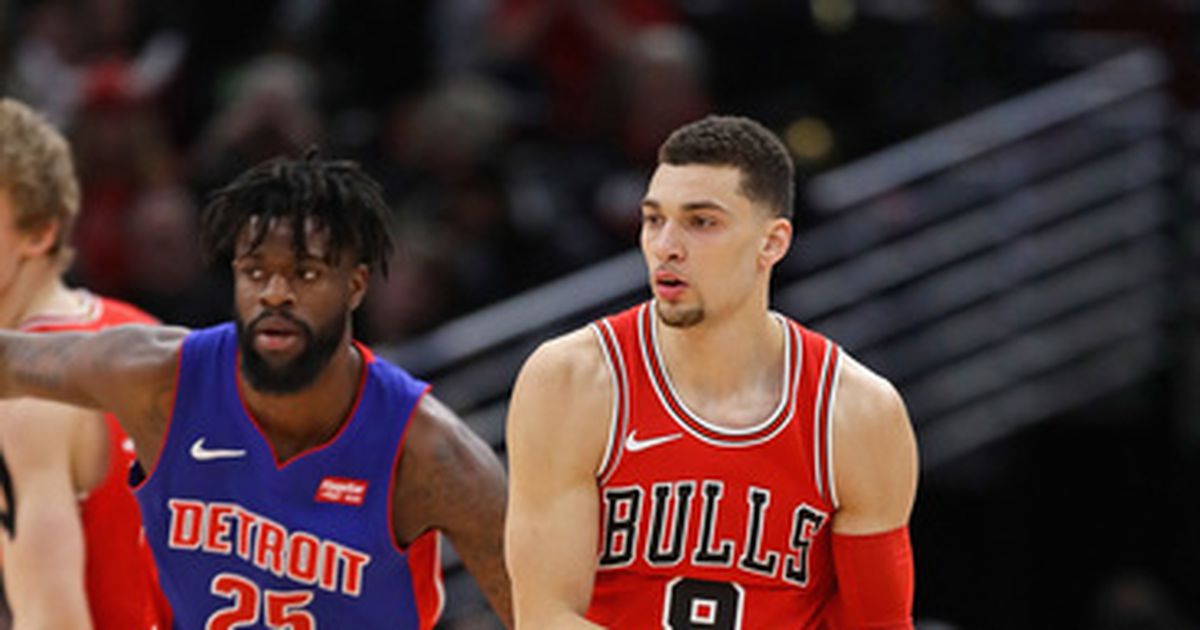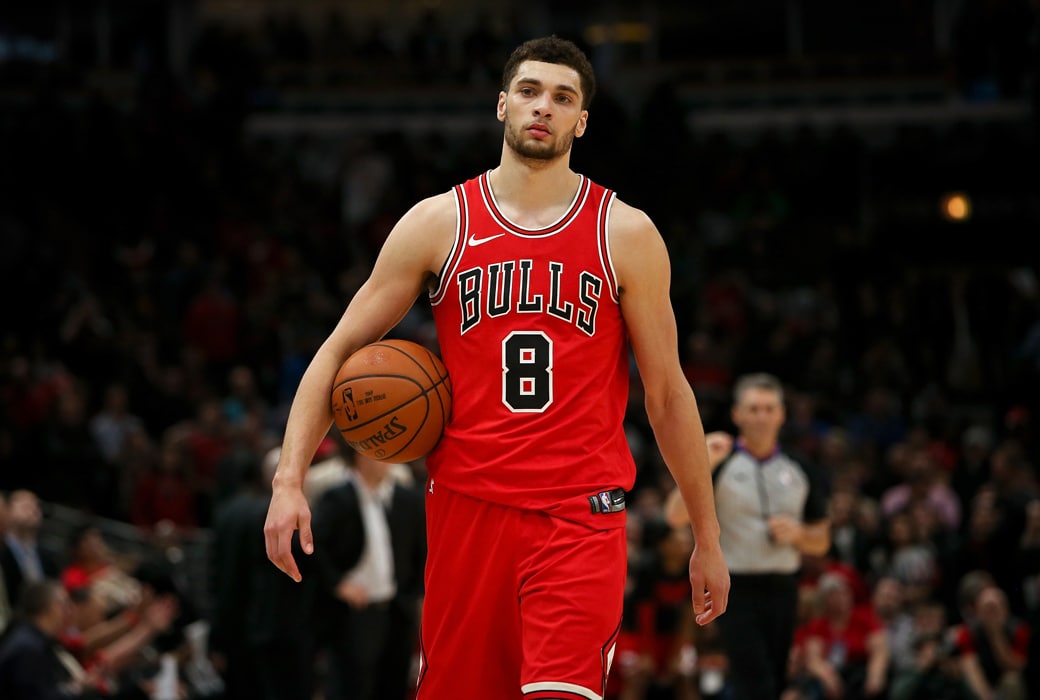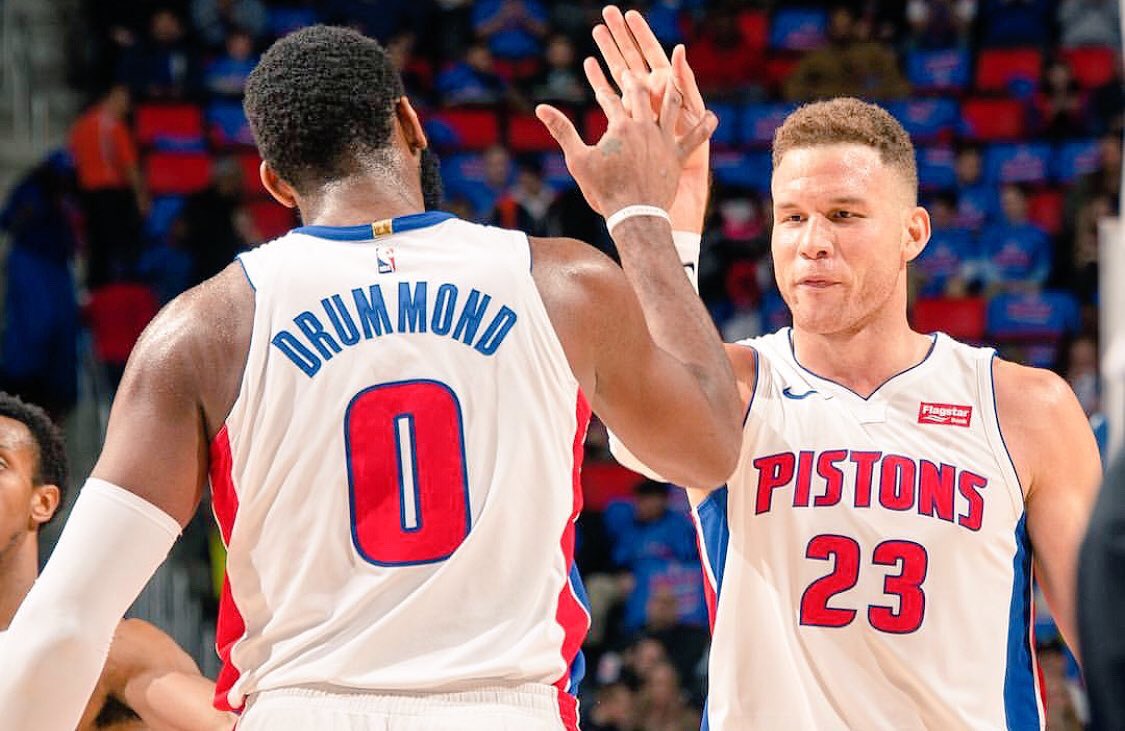|
As the eyes of many NBA fans shift towards the postseason, some front office executives are thinking about how they can improve the fates of their franchises that are not currently vying for postseason play. The pre-draft process is filled with tons of scouting, evaluation periods, internal discussion and workouts for some of the hopeful rookies that want a spot in the NBA. Taking the drafting needs and picks into consideration, financial considerations can paint the biggest picture to what decisions will be made beyond the draft. Trading some players, utilizing cap space for taking on others, and preparing for free agency all are highly informed by the team's salary situations – after all, the NBA is a business. Chicago's basketball team has seen brighter days, but have found a decent litany of young pieces with which to build. They still need their franchise cornerstone, and with Zach LaVine hitting free agency and other costs low, will have to figure out how to bid against themselves. The Detroit Pistons are on the other end of the spectrum after striking a mid-season trade for their superstar in Blake Griffin. As they evaluate the futures of Stan Van Gundy, they must find a way to put their expensive pieces together and make the postseason. Chicago Bulls 2017-18 Record: 27-55 2018 Draft Picks: 6th*, 22nd (from NO) Restricted Free Agents: G Zach LaVine, G David Nwaba, F/C Noah Vonleh Unrestricted Free Agents: none Other Players of Note: G Sean Kilpatrick (non-guaranteed contract), G/F Paul Zipser (non-guaranteed contract) Committed Salary: $61,579,487 Cap Space: $39.4 million The draft lottery could be more important to the Bulls than other teams that won fewer than 30 games this year. Chicago's roster is filled with impactful young role players or solid pieces: Kris Dunn, Lauri Markkanen, Bobby Portis, Denzel Valentine, Jerian Grant. Add their three restricted free agents, all of whom they could re-sign, and there are a ton of pieces to grow and mature together. They just need a marquee two-way player. By winning the lottery and getting one of the highly-coveted big men rim protectors in the draft, the Bulls path forward becomes so much more clear. Without that taking place their front office has some interesting decisions with how to proceed, both with the draft and on the trade market, to get the most out of their roster. 1. If you don't win the lottery: conservative early, swing for the fences later If Chicago doesn't make the jump into the top-three in the draft, the Bulls need to remain open to trading down. Depending on who is available at 6th overall, there could be an opportunity for Chicago to trade back a few slots, pick up additional picks, and then add to their depth. If DeAndre Ayton, Mo Bamba, Luke Doncic, Jaren Jackson and Marvin Bagley are all off the board quickly, Chicago doesn't have to try and swing on Michael Porter or Wendell Carter if they don't love their fits. Teams like the Clippers (who have 12 and 13) might be persuaded to trade up for one of the many guards available. Charlotte could look to move up into the spot and unload some salary to Chicago, helping the Bulls get a nice haul in return for the double-favor. Even Philadelphia with 10 and 26 could try and snag the guy they fall in love with. The point is this: Chicago has a clear need for a big man and a superstar; if the two aren't clearly one in the same, why not trade down and get more swings at the Piñata? Chicago acquired the 22nd pick from New Orleans in the Nikola Mirotic deal, and dependent on what they do earlier in the draft, have a full roster and plenty of young players already in tow. They could shop the pick and punt it back to next year, but there are plenty of boom-or-bust candidates a little later in the draft. Instead of reaching at 6 on a guy they're less comfortable with, 22 is the place to swing for the fences. What about the hyperathletic big man Mitchell Robinson? Anfernee Simmons, the smooth shooting combo guard from IMG? International picks like Dzanan Musa or Elie Okobo could also be in play here, where the Bulls add to future depth and don't utilize a roster spot. 2. Trade Sean Kilpatrick before July 1st, or eat salary before the draft Somehow this signing's brilliance went beneath the radar, but perhaps that's just Bulls fans not wanting to give credit to GarPax for making a shrewd decision. The Bulls signed Sean Kilpatrick to a three-year deal this March with the remainder of their MLE. But Kilpatrick's second and third years of the deal are non-guaranteed so long as he's cut before July 1st. The Bulls almost certainly won't have him on their roster next year. Sure, they could just cut him and then replace him with their incoming draft picks. But there are plenty of teams that could use the cap space Chicago has and would be willing to swap Kilpatrick's $2.1 million for a dead weight deal of around the same value. Chicago would be compensated for eating the ~ $2 million of some other deal (one they would likely waive anyway), but it's a way to use their $39 million in cap space to add other draft picks instead of just cutting Kilpatrick. Would a team like Cleveland pay to unload Ante Zizic? How about Toronto with Malachi Richardson? Lots of opportunities for the Bulls here, but remember: they have been acting as an above-the-cap all year to hang onto some trade exceptions, so they can't take back more than 120% of their outgoing salaries. In addition to the Kilpatrick $2.1 million trade chip, Chicago also has a $15.3 million trade exception that expires on June 22nd. While the Bulls likely don't want to simply add $15 million to their bill, there are teams out there that would pay handsomely to lose that much weight. Would the front office consider eating the salary of Marvin Williams for a first-rounder? What about Solomon Hill, or Gorgui Dieng, or Meyers Leonard? The point is there are options out there that the Bulls should at least explore. 3. Waive Omer Asik via the stretch provision Timing is everything, and the Bulls took back Omer Asik from New Orleans this past winter knowing they could stomach hanging onto him this season. During the 2017-18 season, Chicago carried with them more than $26 million in dead weight - salaries that were outgoing to players not on their roster. That number drops to zero on July 1st. The NBA grants teams through the CBA something called the stretch provision, which allows teams to waive a player and stretch the guaranteed money remaining out two-times plus-one the remaining years of the contract. So if a player is signed for two years, a team can waive them and stretch that money out over five seasons (2x the years + 1 season). That happens to be the case with Asik, but the emphasis with him is on guaranteed money. Asik's final year of his deal, a player option, carries with it a mere $3 million guarantee. Once the new cap year begins the Bulls can waive Asik's $11.28 million, plus the only $3 million for 2019-20, and stretch that amount across five years. That would be a cap hit of $2.86 million per year. Had the Bulls, or Pelicans, tried to stretch Asik this year, that number would climb to $3.55 million. $2.86 million isn't an incredibly small number, but Chicago has space to spare and could use the roster spot. Losing him and swallowing $2.86 million also $8.4 million to their cap space, meaning Chicago would then have north of $47 million to play with in free agency. 4. Know your competition for LaVine Someone explain to me which teams are competing with the Chicago Bulls to sign Zach LaVine? The restricted free agent that shot 38 percent from the field in 24 games with Chicago is a bit of a polarizing player. Coming off ACL surgery and having a rather mundane showing should mean some other teams are scared of throwing the ton of cash that would be necessary to pry him away from the Bulls. Cap space is a premium around the league and there are other RFA's available that could be signed with as much upside and far less risk. That said, the Bulls are essentially heading into this summer knowing the market is theirs to negotiate with LaVine. The front office should then drive a hard bargain and not overpay for LaVine until someone comes in and goes towards the max. A four-year, $80 million flat deal might be the best benchmark for the organization. 5. Shop the veterans on expiring deals Robin Lopez ($14.4m) and Justin Holiday ($4.38m) could be attractive pieces to some teams looking to win games now. Chicago should see what the markets are for those guys, but not have the need to pull the trigger on a trade right now. Their value may increase through the season and be at its highest near the trade deadline. Shopping guys is about establishing a baseline for value with trade partners so Chicago can call back in January and February and know where the dialogue began. The roster should be tight in Chicago, especially with them wanting to bring back RFA's LaVine and Nwaba. Poor roster management with any of the first four factors could force the Bulls into making a deal with their veterans before their peak value is established, and that would be a tough pill to swallow for the organization. Detroit Pistons
2017-18 Record: 39-43 2018 Draft Picks: 42nd Restricted Free Agents: none Unrestricted Free Agents: G/F James Ennis III, F/C Anthony Tolliver, PG Jameer Nelson, G Dwight Buycks Other Players of Note: G Reggie Bullock (non-guaranteed contract), F Eric Moreland (non-guaranteed contract) Committed Salary: $110,968,896 Room Below Luxury Tax: $13 million Detroit traded their first-round pick to the Los Angeles Clippers in the Blake Griffin deal, and now they find themselves with an interesting dilemma. The Pistons are committed to playing through two fantastic playmaking bigs and a unique frontcourt pairing in Griffin and Drummond. Between those two and point guard Reggie Jackson, the franchise will pay $74.5 million to experiment with just these three players. The Pistons have gotten underwhelming contributions from their recent first-round picks of Stanley Johnson, Henry Ellenson and Luke Kennard. Without many clear ways to get younger, this team must make significant strides to make the playoffs next season to prove these investments worthwhile. What moves can they make this summer to succeed at that task? Order of Operations 1. Figure out if Van Gundy is your guy before May 1st Stan Van Gundy is often underappreciated as a coach. He's a proven winner and a brilliant basketball mind. The experiment of installing him as both head coach and President of Basketball Operations has proven to be a failure though – one that other organizations around the league are experiencing as well. How the two sides work to remedy those difficulties is a big test for the Pistons: will Van Gundy remain as coach and cede front office control? Will he leave altogether? And what will the Pistons do if he needs replacement? Why such a hard deadline for a team that doesn't have a first-round pick? It's about the organization bringing in the right replacement and having a firm plan in place before July 1st. There are plenty of trading windows open on draft night, and the longer a new coach or GM has to get in sync on what moves to make, the better off the team will be. 2. Avoid the luxury tax at all costs The 2019 summer sees Detroit basically unable to avoid the luxury tax based on their roster makeup and the restricted free agency of Stanley Johnson. How do the Pistons reconcile that and avoid the repeater tax? By making sure they're financially shrewd this year and avoid going over the luxury tax line. It's an organizational imperative many teams are putting into play, and Detroit must do so as well in the wake of their struggling new arena. The 2019 summer will open with, as of now, more than $105 million on their cap sheet, plus whatever they add to it this summer. They then must deal with paying Stanley Johnson, two key free agents in Ish Smith and Reggie Bullock, and the cap hold for their first-round pick. The path to avoiding the tax is so much easier this season than it is in 2019. The Pistons can either avoid the tax by pinching pennies this summer, trimming salary via trade or both. Below we dive into the different risks of each option... 3. Make a judgment call on James Ennis Ennis was acquired from Memphis at the trade deadline, and his Early Bird Rights came with him. What does that mean? The Pistons only have a slight advantage to retaining him on the free agent market: they can offer no more than around a $6 million per year starting salary to Ennis. Arguably Ennis is worth that much, but another team with space or the full MLE could come in and use more. If Ennis is to stay in Detroit, the Pistons must decide early if they'll use their own MLE to keep him, or if they'll spend it elsewhere and risk Ennis leaving if the $6 million per year isn't the largest offer he receives. Their finances put the team in a bind to a certain extent. Once Ennis is signed, the team only has around $7-8 million below the luxury tax. The non-tax Mid-Level Exception is valued at $8.8 million, but using all that amount cannot be done that close to the luxury tax due to the hard-cap rules. With four open roster spots and only $13 million (and the anticipated $5-6 million from Ennis), a full $8.8 million would push them above that line, meaning they cannot accomplish both. That's why the decision with Ennis is so crucial: once he's locked in, the Pistons lose about $3 million in spending power elsewhere. So the franchise has to decide: is it better to have Ennis and $5 million of a MLE, or $8.8 million of a MLE and have to replace Ennis? Part of the equation comes to what they can get with both, part with their value in Ennis, and part with whether the organization will be willing to go into the luxury tax (more on that later). 4. If they use the Full $8.8 million... The Pistons do have the option to use that full $8.8 million, and offer essentially three veteran minimum deals elsewhere to fill out the roster. Anthony Tolliver and Jameer Nelson could take up two of those spots and minimize the amount of roster turnover. Moving on from Ennis could see essentially little change to the roster and a simple upgrade on the wings. They should target playmaking wings with this spot. Will Barton is an ideal fit, as defensively he guards wings and offensively adds another PnR ball handler that allows Reggie Jackson to play off-ball. Rodney Hood is another interesting fit; he's young, great in dribble handoffs (a staple of their new offense with Griffin and Drummond) and available to be pried away from Cleveland. Even sharpshooter Joe Harris would be a welcomed addition to the group. All three are clear upgrades over James Ennis, which is why this course of action seems more likely to me than retaining Ennis. 5. Shop guys like Jon Leuer, Ish Smith and Langston Galloway There are some good pieces in Detroit on their bench, though some of them may not really be necessary. Galloway, Smith and Leuer are above-average role players, but the financial crunch in Detroit will be difficult to overcome if they keep high-paid backups and veterans. If the opportunity presents itself for the team to flip any of them this winter for a pick or a solid player on a rookie deal, they absolutely have to take advantage of it. The issue is that few teams want to pay that much money for a backup, especially before the draft. If any of these guys get dealt, that is likely to happen next winter and closer to the trade deadline. This should illustrate how difficult the task ahead of the front office in Detroit. They have a new arena they're struggling to fill, an expensive roster with a win-now necessity and a spending ceiling that's closer than it appears. Can the Pistons juggle all these troubles and still make the Playoffs next year? How they manage this summer is crucial in providing the answer.
0 Comments
Leave a Reply. |
Adam SpinellaHead Boys Basketball Coach, Boys' Latin School (MD). Archives
September 2021
Categories |



 RSS Feed
RSS Feed
